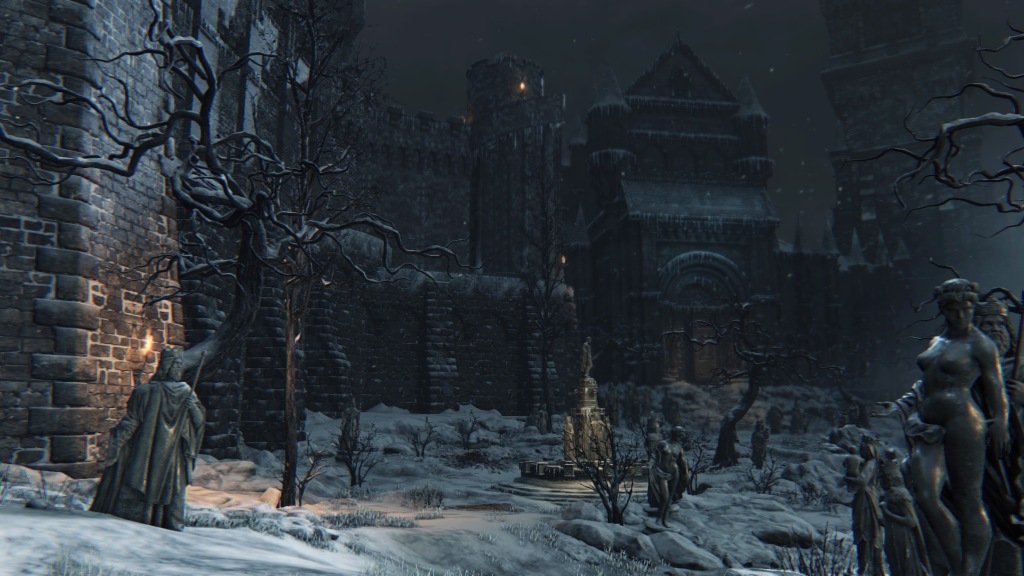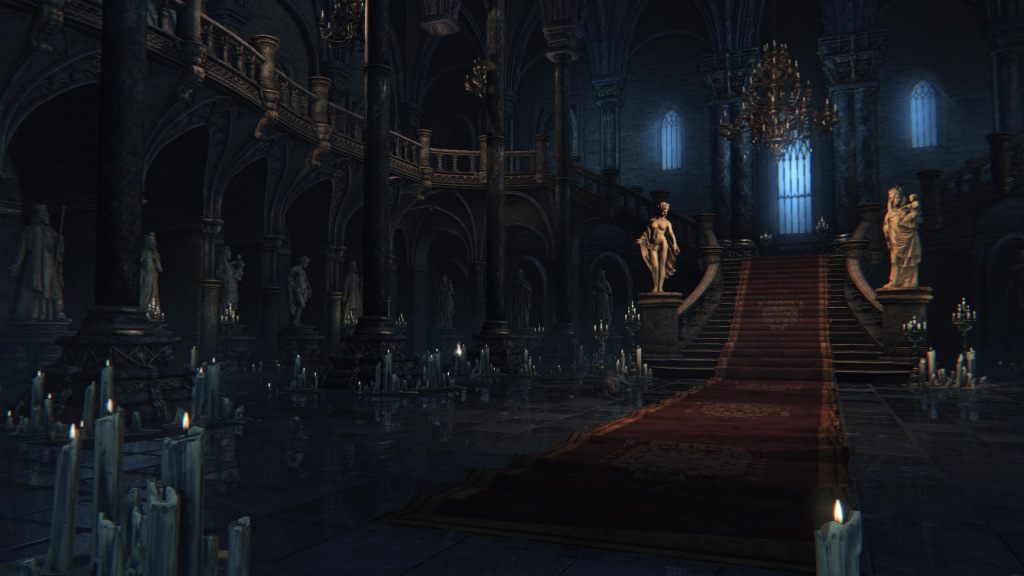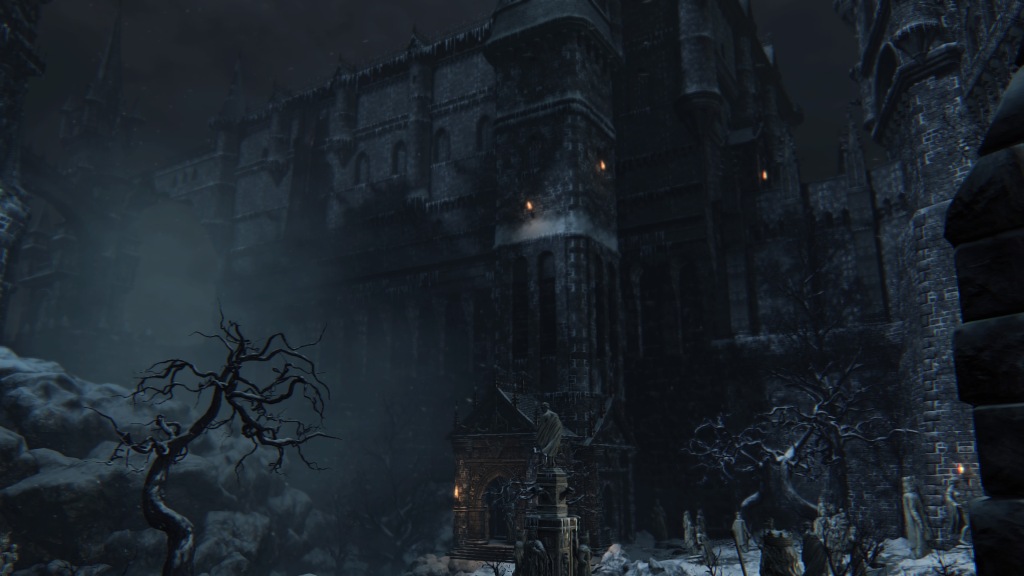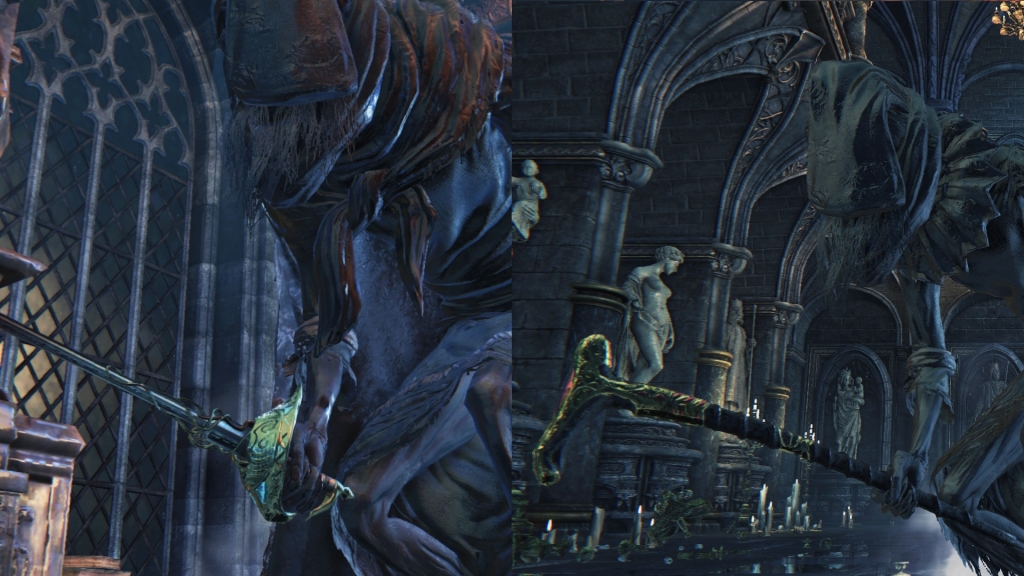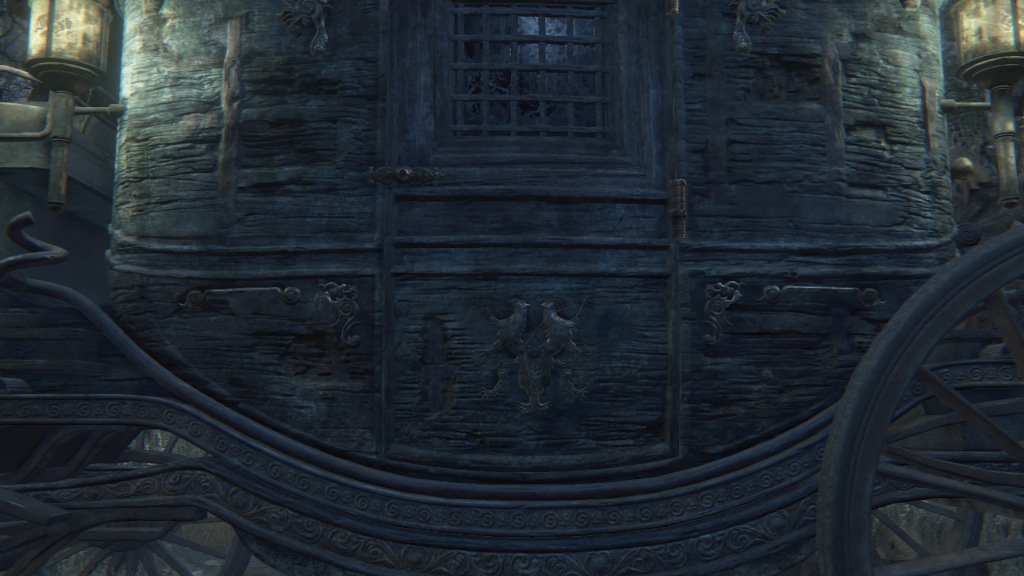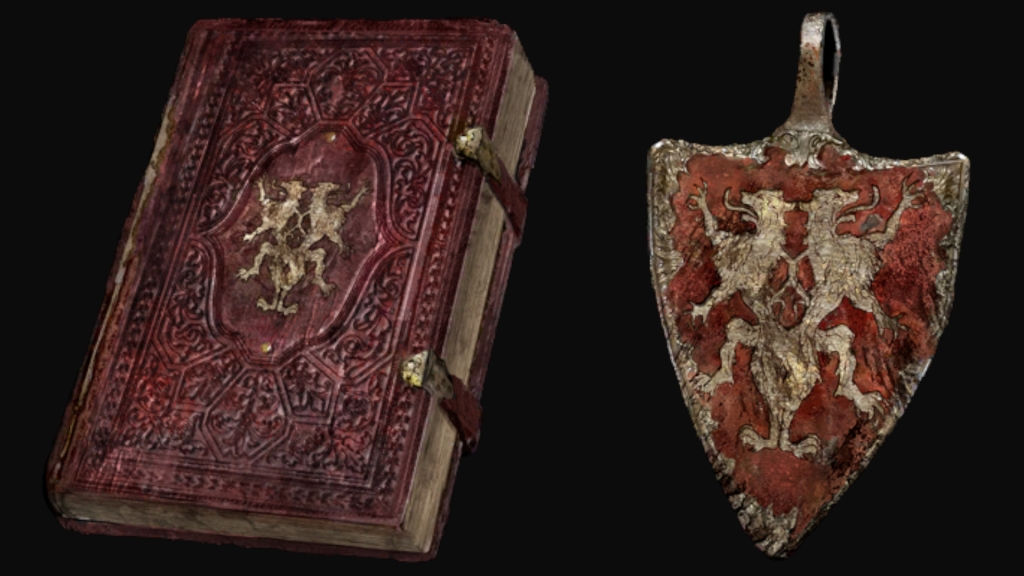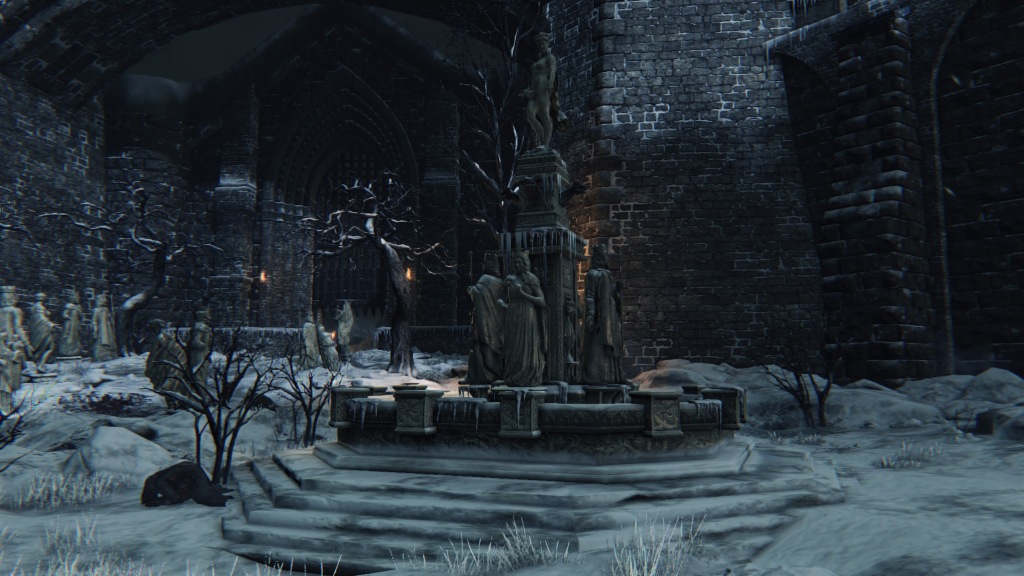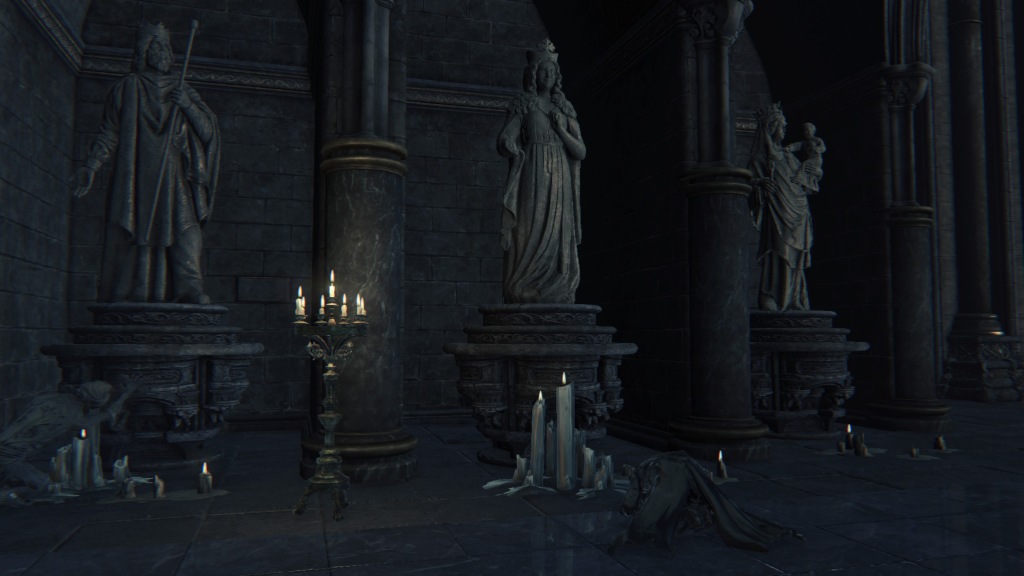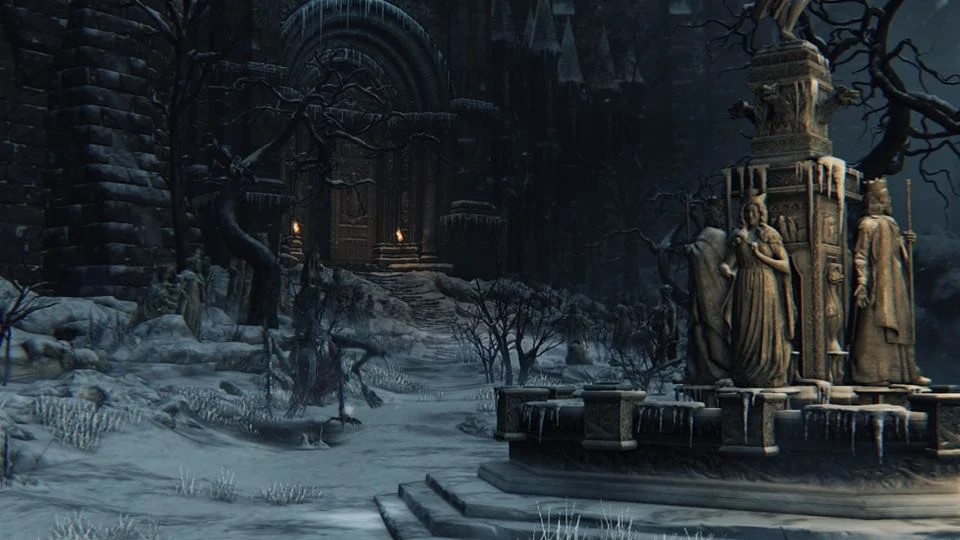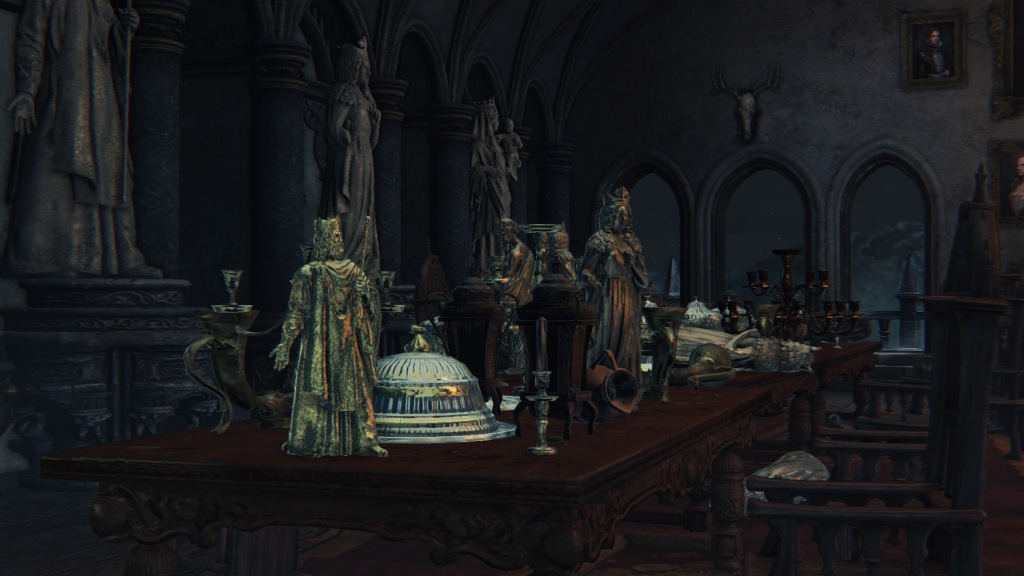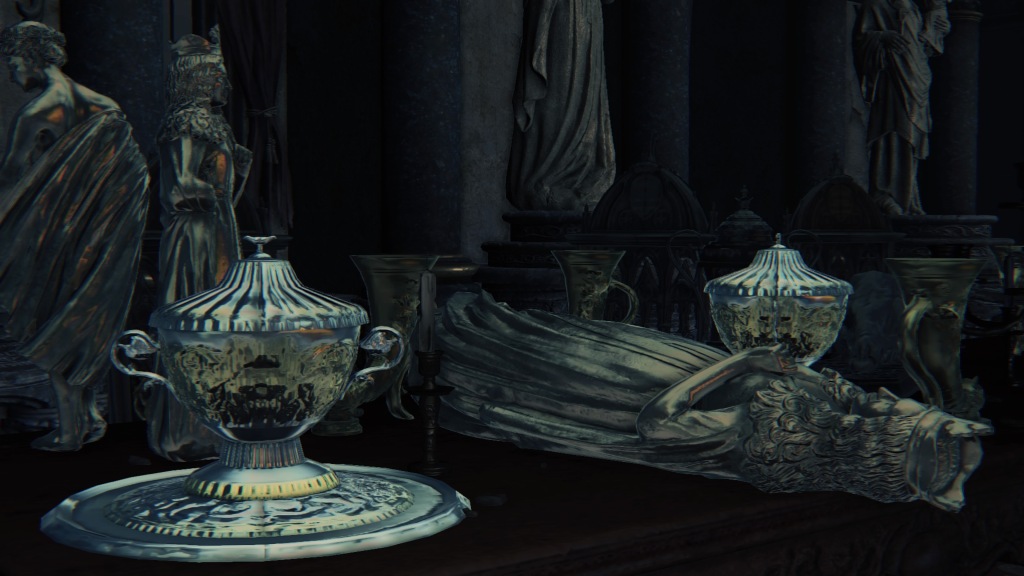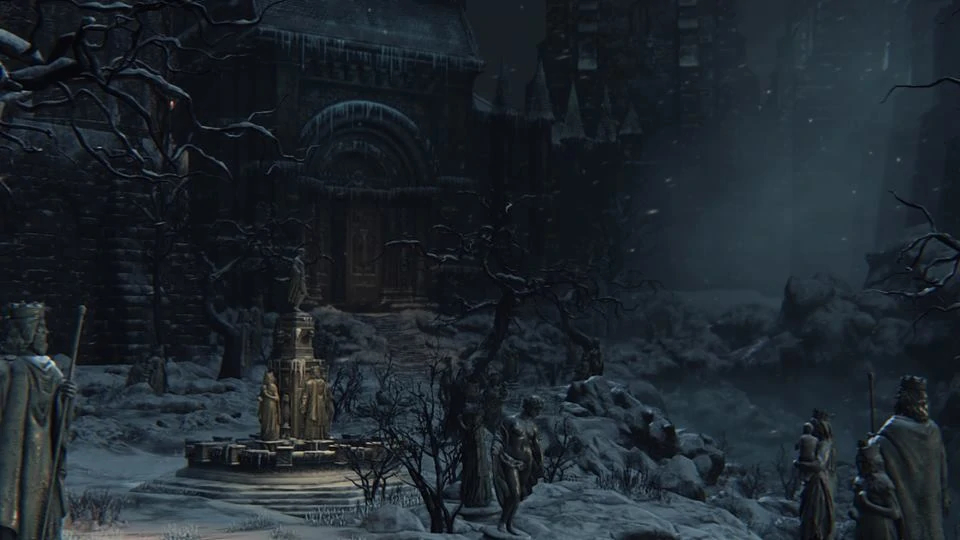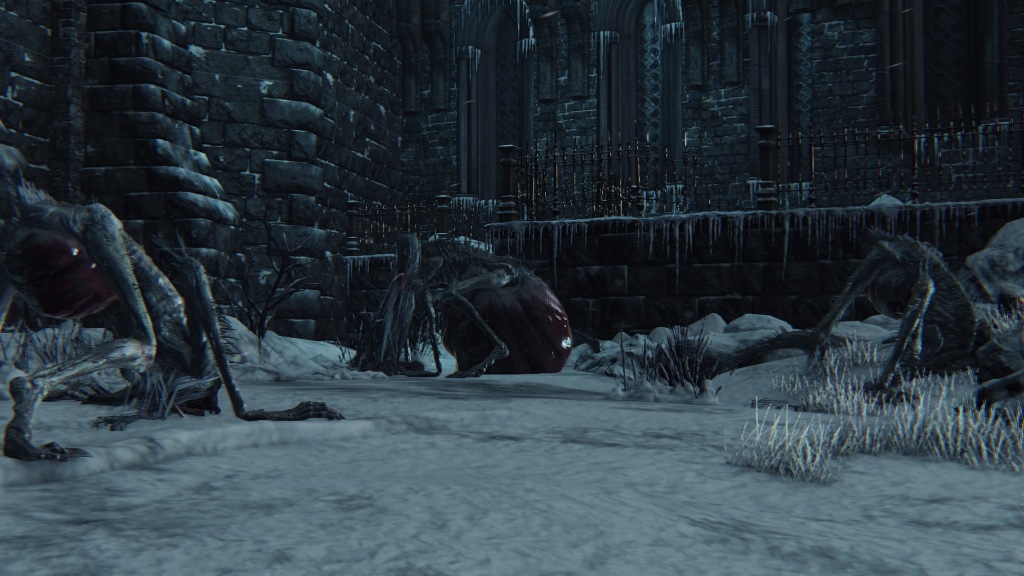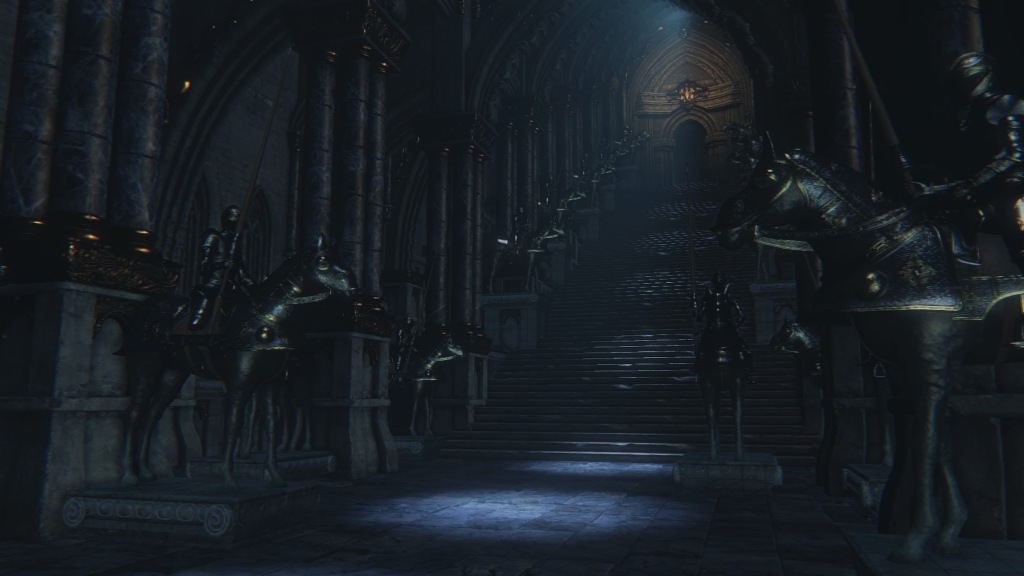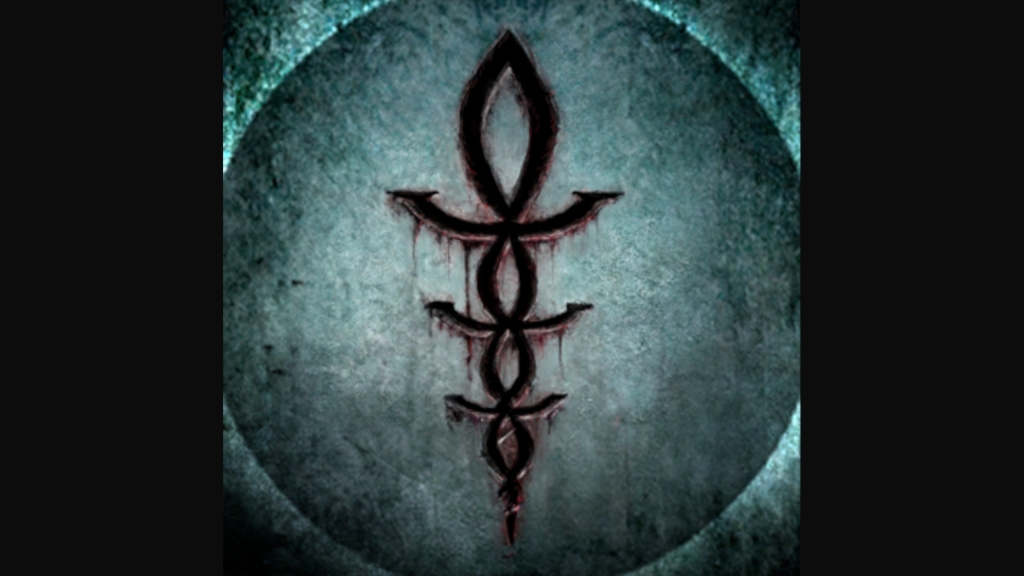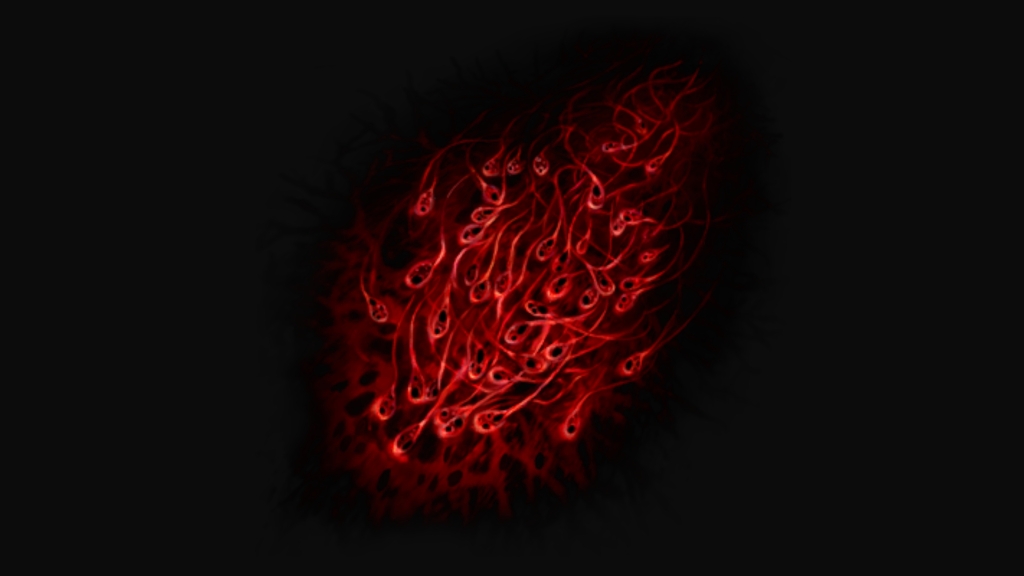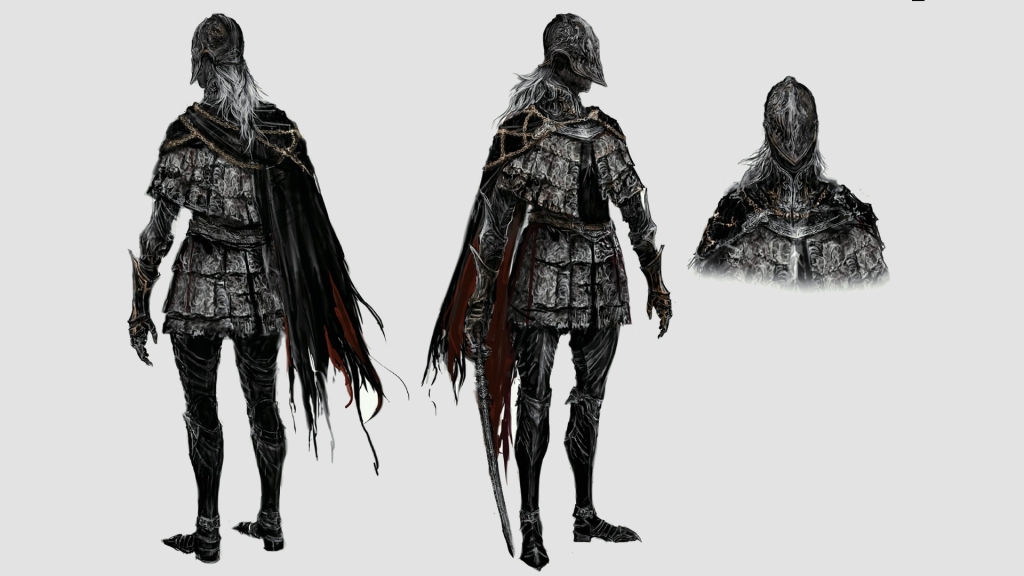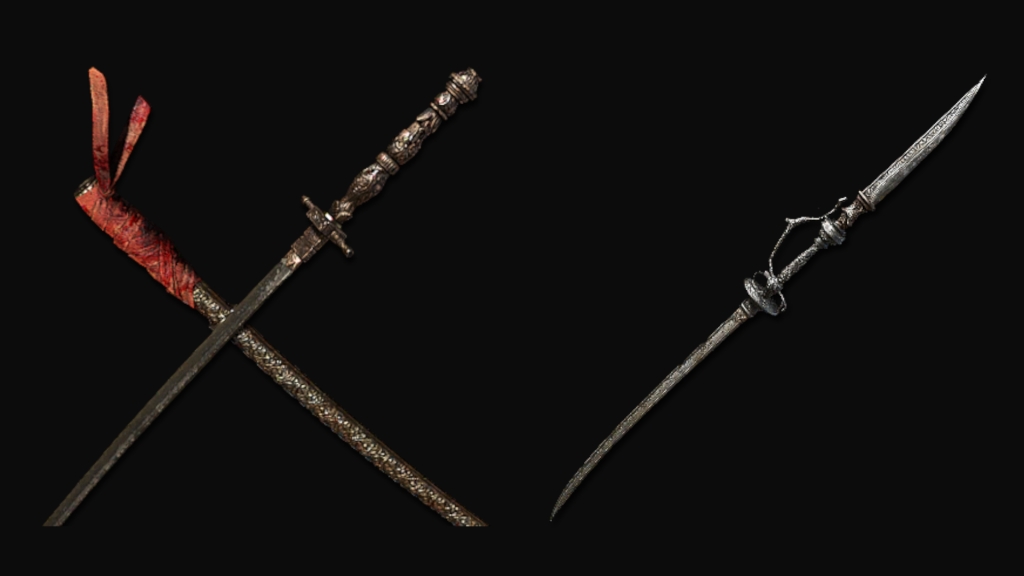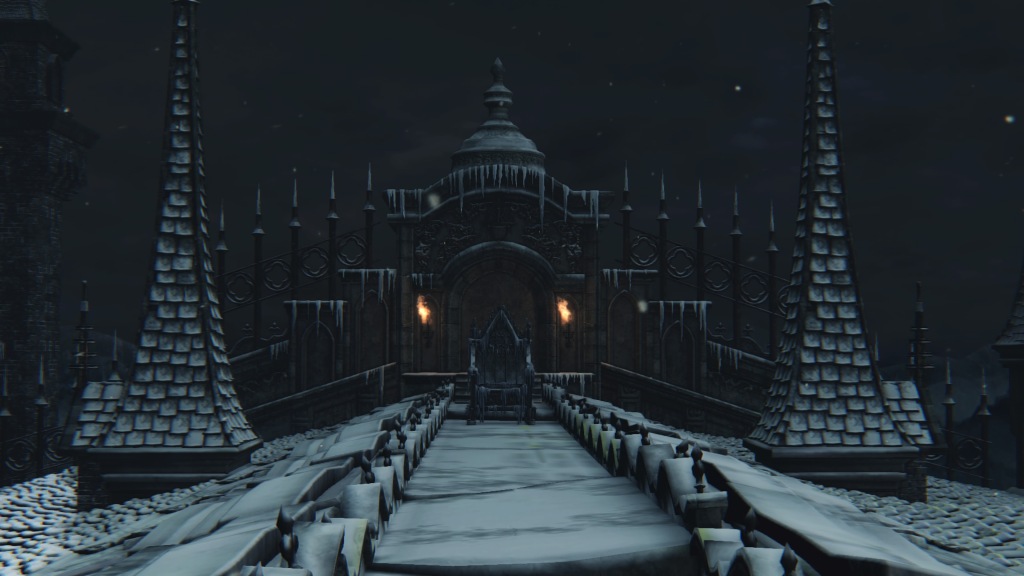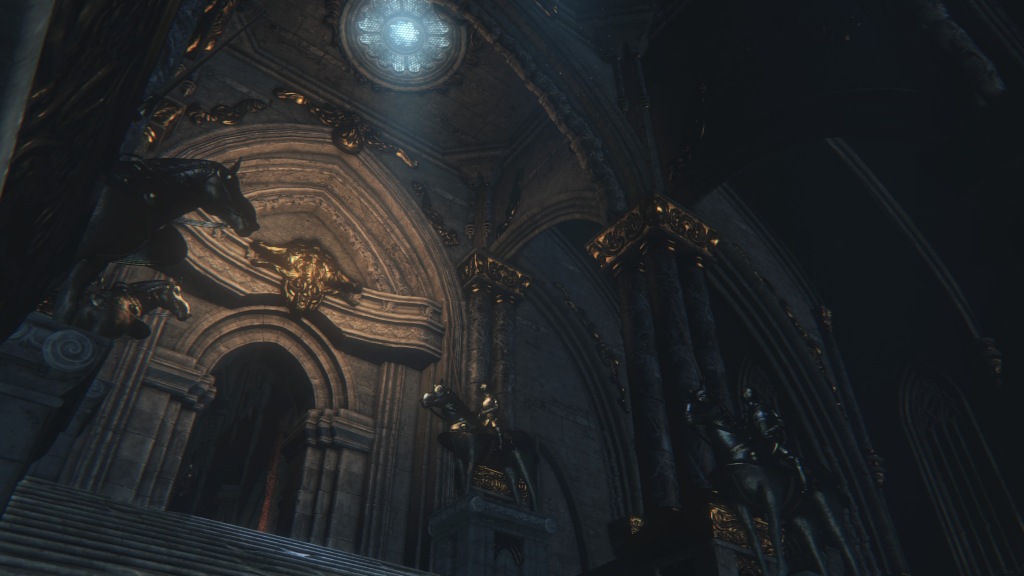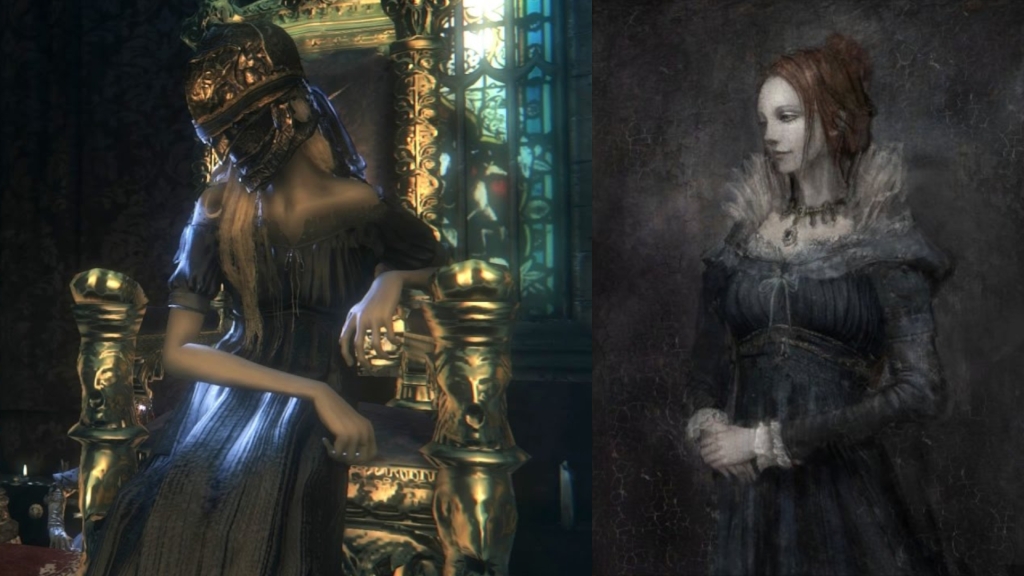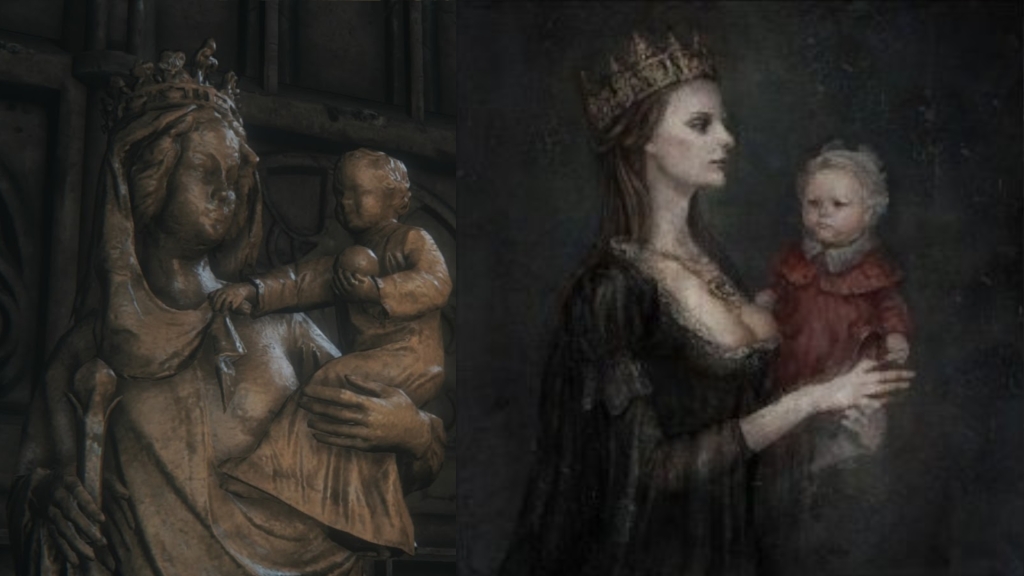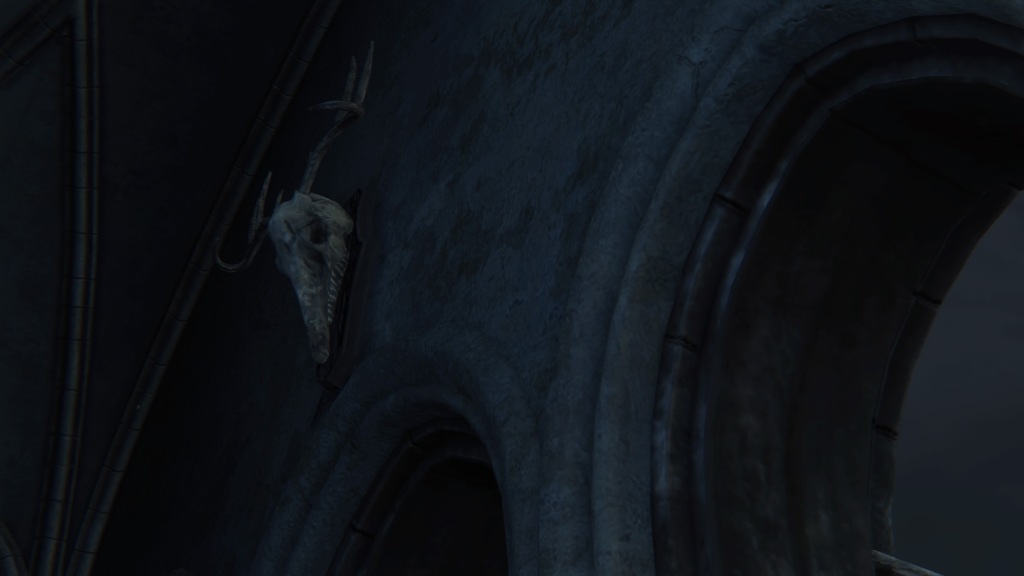Preface
Although Castle Cainhurst isn’t as expansive as I would have liked, the story behind it is still probably my favorite in Bloodborne. Gothic, medieval, evil, aristocracy, vampires; what is there not to love? It is one of the few areas which stays true to the horror inspiration the game initially presents while also seamlessly integrating it into the wider cosmic setting. The fact that such a small space is so dense with detail is a testament to Director Hidetaka Miyazaki and FromSoftware‘s environmental storytelling — albeit, chest placement could have been just a bit more deliberate. To sum up, it is an excellent concept slightly hampered by a flawed execution. Get past the defects, and it is a real gem.

The Show Must Go On
Holed up in their castle on a small island off the coast of Hemwick, the clan of nobles going by the name of Cainhurst, commonly shortened to “Cain”, (カイン) lived lavish lifestyles. Men and women dressed in vibrant and intricate, if old-fashioned, formal wear while elegantly dining at large dinner tables lined with sumptuous meals. Their opulence was only matched by their foppery, inviting outside guests to take part in these gaudy banquets. These written invitations seem to have been sent out to foreigners in particular. Eastern weapons like the Chikage found their way into Cainhurst’s arsenal, while the glove passed down a foreign executioner’s family was added to the clan’s private collection — the wrathful spirits it summons with the smattering of blood serving as an excellent sideshow at their parties. This interest in the outside world is also made manifest in their extensive library, countless books doubtless regaling them of all the peoples and things they would ultimately gather in their castle. However, welcoming in these outside influences might have been a deception.
Finely-tailored dark red dress.
It is clothing of nobles who were related to the end of the old bloodline of the now ruined Cainhurst.
One of the secret treasures collected by Cainhurst. Glove of an executioner of a foreign country.
That which was probably passed down the executioner’s family line generation after generation and stained with copious blood is now home to endless vengeful spirits, and a blood catalyst summons them.
It is said that the nobles liked this and enjoyed the vengeful spirits’ wild dance.
Like Yharnam, Cainhurst had a tradition of blood-drinking. The Japanese description for the Reiterpallasch confirms that the old bloodline long had a “taste” for the stuff, and their servants carry blood vials. These bottles of transfused blood were probably looted from their now dead masters, since the menials also wield fancy canes — emblematic of sophisticated people — and rapiers — emblematic of nobility in Miyazaki’s previous titles, Dark Souls and Demon’s Souls. Cainhurst’s royal guards were similarly knighted by imbibing the blood of their queen, with each member’s name recorded in a directory since a similarly long time ago. Add to that, all Cainhurst attire is highly blood resistant. The aristocrats loved it so much that they would even collect warm blood gemstones, one of which a resident stored away in a chest. This predilection is presumably why sanguine red is the key color in Cainhurst fashion and heraldry. Such a habit also means that the clan were no strangers to the beast scourge.
Red-leather directory of the bloodkin who forged a covenant with Annalise, Blood Queen of Cainhurst.
All the names of the bloodkin have been written down in it since long ago. They are blood hunters who hunt prey in search of “corruption”.
The so-called knights were “retainers” (従僕) whose title was intended to imbue their unseemly role slaying former nobility with honor. Differing from the “Cain servants” (カインの召使い) obsequiously lurking around the castle in meager attire, these attendants were more likely nobility themselves. Portraits in the castle depict one such knight with the clan’s features, and the order loved Evelyn — name meaning “beautiful bird” — like a woman because the specialized firearm took advantage of superior blood quality typical to bluebloods. It wasn’t uncommon for nobles of lower status to attend to more ranking aristocracy in medieval Europe, and this would explain why they dressed just as luxuriously and nobly as their masters, making their bloody affairs as decadent and awful as every other aspect of the Cainhurst way of life. If they must regularly perform such sordid affairs, as they wined and dined, at least make it beautiful for the onlookers. Only, it is expressly their “secret” duty. The question is, from who?
The “spawn of old” (古の落とし子) possesses the body of a bat but the head of an elderly man, his features matching one of the castle portraits. We can thereby presume the creature a noble from an older time, having since transformed into an immortal beast. The monsters possess a similar weakness ratio to fire versus arcane or bolt damage as the standard beast, and they can perform similar stunning roars and blood-sucking bites. While they don’t share the same weakness as most beast type enemies, this can be attributed to a lack of fur, same as bloodlickers. In that case, it is most likely the beast form that at least some of the nobles have taken on, having survived in the castle for so long thanks to their flight capability and heightened intelligence — some blend in with the statues to lie in ambush or evade extermination. Disposing of such beasts thus must have been a constant priority. This was the task left to the knights stationed at the castle. But the clan considered even this an opportunity for garish entertainment.
Apparel of Cainhurst knights. Very noble clothing colored with gold thread embroidery.
The Cainhurst way is nostalgic and grandiose. That is precisely why beast disposal was filled with beauty and honor as a bloodstained, decadent art.
Weapon that knights of Cainhurst used. It combines a large knight sword and a unique gun.
The nobles who have had a taste for blood since long ago were thus neighbors of the blood disease, and beast disposal was the secret role of their retainers.
If you become accustomed to calling your retainers knights, is it not at least honorable?
Unique gun that knights of Cainhurst used.
Its use of Quicksilver Bullets is no different from a workshop gun, but that of Cainhurst tends to emphasize blood quality more.
This gun, which bears a woman’s name, is an exquisite gem even in its design, and it is said to have been well loved by the knights.
The knights cannot be hiding this disposal from the nobles who dub them “knights” for that very purpose. Even the Cainhurst heraldry features beasts in positions and poses typically reserved for lions or horses. Therefore, it must be something kept secret from the outsiders they welcome to visit. These are the folk who would presume that they, like knights in other countries, existed only to protect their lords or ride off into battle. Indeed, their choice of weapon is the Reiterpallasch, a weapon whose Germanic name roughly translates to “cavalryman’s broadsword”; the pallasch also saw use by Victorian Era cavalry. The outside world wasn’t supposed to know about Cainhurst’s beast problem, and the same likely held true for the blood-drinking behind it. Corpses in the foyer show that those who do are liable to go mad from the castle’s horrors as soon as they entered. In that case, what about their extravagant parties inviting foreign guests? How did they get their hands on foreign weapons and armor? And where exactly was all this blood they liked to indulge in coming from?
Most likely, the guests were the ones providing the exotic drink, the clan taking their knowledge or trinkets with their lives. The gemstones they keep do show a preference for blood that is still warm, and they have passed down the recipe for numbing mist — simply incapacitate the victim so as to not spill blood too soon. Human bones do ominously lie at the bottom of the fountain in the castle plaza. Murder would likewise explain their choice to escort guests inside via their own private carriages — horses bringing them in so they don’t have to come back out. This left the castle without risk. No local would care to notice a passing foreigner gone missing, and how could anyone back home pin it on the castle in the middle of nowhere? Highwaymen, wild bears; there are countless dangers in traveling such a remote land. At worst, Cainhurst might suffer from ominous rumors, but the promise of a night in the high life would likely offset the next guest’s concerns. And with guests bringing ingredients for the next banquet, there would be plenty for Cainhurst to celebrate.
Moving Up in Life
Aside from evoking classic 19th century vampire horror, this reclusive yet bombastic family of blood drinkers brings the Pthumerians to mind. The numbing mist that “only” they circulated is nonetheless found in the labyrinth, implying that the clan originally inherited the recipe from Pthumeru. The same can be said for their use of trick weapons which split in half or combine swords with firearms, as well as their knowledge of silver warding off malicious blood. We are also only able to propose to the queen with a Pthumeru wedding ring. The overabundant statues of women, especially the queen, over men similarly indicates a Pthumerian matriarchy — as does the corpse prostrated toward one. In fact, the icon of the Queen so often juxtaposed with the King in Cainhurst is the same offered up in the labyrinth; the castle’s fancy dining receptacles are also among the offerings. The clans’ pale skin and, typically, silver hair are consistent with the subterranean gravekeepers as well. Even portraits depict one noble dressed akin to Pthumerian bell ringers. Without a doubt, Cainhurst descends from Pthumerian stock.
Secret medicine that generates a numbing fog if thrown. Dulls a hunter’s sense of the power to live and obstructs HP recovery.
It is said that the blood hunters of Cainhurst use it, and even its recipe is only handed down to the noble clan of that castle.
We can also confirm their direct connection to the labyrinth from the destroyed building in the castle courtyard. Even completely reduced to rubble, the surrounding architecture suggests that it was a sizable edifice connected to the royals’ wing of the castle. It included a basement, as the foundation has collapsed below ground level to form a depression. And although the rubble bars further investigation, the enemies crawling out are very telling. One is the bloodlickers; the other, the parasitic insects. Both originate from the labyrinth, so this basement must have connected to the Pthumeru ruins. One corpse with numbing mist prostrated in the rubble’s direction reinforce that implication. Being evidently hallowed ground, perhaps it built upon the ruins’ role as a graveyard, much like the Forbidden Woods cemetery — a mausoleum would provide the nobles with both a fittingly lavish burial, and its importance explains the royalty’s direct access.
By all indications, Cainhurst was founded by Pthumerians who came above ground the same as Yharnam. The biggest difference is the kind of life each tribe wished to pursue, which traces back to their disparate origins. Most corpse blood collected around the castle is maddened, some even reaching the level of kin. This can’t be faulted on their peculiar diet since we don’t see this same quality from Yharnam, leaving lineage as the only explanation. In short, the clan comes from Pthumerian nobility. Indeed, as we head deeper into the Chalice Dungeons, the corpses lying dead and unburied around the ruins begin wearing black knight armor. This is the same armor donned by an old Cainhurst noble in one of the castle portraits; it is also similar to the decorative suits of armor preceding the royal audience chamber. That the latest generation never wear such equipment indicates them to be artifacts inherited from Pthumerian knights. The bath messengers in the deepest Pthumerian Chalice Dungeons likewise sell uncanny and lost varieties of Cainhurst weapons, reinforcing the connection.
Taken together, some of Pthumer’s ruling class staged a coup after the destruction of Loran. The ensuing civil war ended with failure, forcing the turncoats out onto the surface where they became the proverbial kings of the hill, now an island — the castle’s name does mean “hill of Cain” in reference to the Biblical traitor whose envy drove him to kill his own brother and face eternal exile. While the gravekeepers left the bodies of their traitorous brethren to rot where they fell in battle, the survivors married amongst themselves to preserve their noble blood. Betrayal and banishment also explains why the resulting clan didn’t seem to actually explore the ruins they had access to. Like with Yharnam, their history was left to be forgotten. In its place, they carved out their own little kingdom modeled on their ideal Pthumeru, with them at the top. And placed at the tippy top was, of course, the royalty.
Maria bears all the markers of Cainhurst nobility, but item descriptions identify her as collateral relative to the queen, confirming overlap between the two classes. Perhaps the progenitor of their line was the rebel leader, perhaps even part of the Pthumeru royalty. Regardless, the Cainhurst royals maintain the highest quality blood, especially the queen. As expected of one with a name meaning the “grace of God’s bounty” in German, Annalise possesses warm blood whose cut item text describes as exceptionally sweet. Just like the Pthumerian queen’s guard, hers can develop Blood Rapture after tasting such sweetness. It would have even boosted stamina recovery on top of the standard HP restoration, an effect otherwise only exhibited by Arianna’s blood. However, the description for Arianna’s donation plus her choice of dress implicates the prostitute as a Cainhurst noblewoman; her Greek name meaning “very holy” complement the queen’s own. Such empowering energy thus seems to be common to the Cainhurst clan. What makes Annalise’s blood a cut above the rest is the amount of “filth” inherent to it.
“Blood donation” of Annalise, Blood Queen of Cainhurst. Only the bloodkin, blood hunters, who have offered blood vitality are permitted to slurp it up as a special honor.
That blood jelly is specially sweet, and boosts stamina recovery speed for a fixed time in addition to HP recovery.
The clan, and specifically its blood, is regarded as “corrupted” (穢れ) and evil by extension. The latter isn’t without justification, as the spawn of old is particularly vulnerable to “righteous” silver weapons. Aside from evil spirits born of cursed blood, the only other enemy subject to this weakness is the bloodlicker. What does it and Cainhurst’s beastified noble have in common? Drinking copious amounts of blood, especially from those who have been killed and are likely to hold a serious grudge. Perhaps this is the reason for the two beasts’ more human physiology and hairless white skin. Regardless, it suggests that the clan’s corruption is the result of absorbing much ill will. Indeed, blood “dregs” are the actual “corruption”, which manifests in those addicted to the last wills collected from blood according to the item’s description — and corresponds with the black masses dotting the wills in its menu graphic. Cainhurst blood too is cursed by malice, hence the royal guards wear silver armor for protecting their queen from the day-to-day risk at the castle: nobles with their corrupted blood.
Repulsive thing that the bloodkin of Cainhurst, blood hunters, are said to discover within the death-blood of man.
It is said that blood left will addicts, in other words, hunters, undoubtedly have a high probability of carrying this.
Thus, they hunt hunters, and Queen Annalise will slurp the “corruption” offered up. For the sake of harboring the bloodkin’s dearest wish, a Blood Baby, in her hands.
Silver helmet that royal guard knights who protect Annalise, Blood Queen of Cainhurst, used.
Very thin, cloth-like silver-made armor is thought to repel malicious blood, so them royal guard knights serve as “blood hunters” for the sake of the Queen reliant on this.
For the sake of her someday harboring a Blood Baby in her hands.
What does it say then for guards to only acquire the Corruption rune from the queen’s blood? Drinkers who receive this symbol see their lifeforce recover when approaching death. Such a resistance to die isn’t unlike the immortality displayed by Annalise. Her body remains healthy after years of confinement without food or drink and quickly heals wounds from simple stabbing or bashing; even if thoroughly ground to mincemeat, her flesh will remain warm and wriggle. Her blood’s refusal to let go of its earthly vessel can only be credited to a curse, wills of the dead still wishing to live. This points the blame at the blood’s corruption, which her bodyguards are tasked with providing her more of. In other words, the undead queen, and the royals preceding her, must possess a higher volume of corrupted blood than the nobles. But Alfred indicates that this state was only “born” after the castle was introduced to blood from Byrgenwerth. Annalise’s immortality and assimilation of more blood dregs thus cannot be involved in corruption dating to antiquity. The royal blood’s rune resulted from something else.
Simply put, the clan’s history of drinking the still warm blood of their victims built up corruption within them. More than likely, the royalty used their position of power to claim the highest quality blood, thereby taking the biggest share of the corruption. This wasn’t lost on the rest of the clan. Servants use their masters’ canes to fire quicksilver bullets that mark targets with an arcane glyph of Corruption, which grabs the nobles’ attention. The corruption was widely recognized in the castle, and probably not viewed so negatively. Although the localization refers to the clan as Vilebloods, the term is actually “blood relatives” (血族) or, more literally, “blood family”. This is why Annalise considers us a member as her guard; some of her cursed blood now flows within us, giving us a connection — a relation — by blood. Such corruption stemming from blood-drinking was core to Cainhurst’s identity, a point of pride. And royal blood quite literally emblemized that corruption.
Whether or not foreigners joined the clan prior to Annalise’s reign, Eastern weapons ultimately became the standard for the queen’s closest blood relations, in both senses. The royal guards utilized Chikage while Maria took up the Rakuyo. Perhaps it was because such arms specialize in drawing blood from long gashes — Dark Souls had such curved slashing swords oftentimes even inflict a bleeding status effect. Both the Chikage and Rakuyo were designed with complex engravings on their blades, allowing them to better retain blood of whoever they ran through. Perversely enough, this was primarily intended for the wielder’s own blood as part of the “cursed” art of blood blades. Since this art drains life force in exchange for more deadly strikes, it is natural to limit it to those in possession of the most death-resistant blood. Maria in particular shows that blood blades can extend the range of attacks, and she even proves capable of drawing the blood lost back into her body — as well as exploding it back out all at once. This technique was clearly the royalty’s ace, spearheaded by their guards.
Foreign weapon that royal guard knights who protect Annalise, Blood Queen of Cainhurst, used.
The slightly curved blade is engraved with a complex wave pattern, and coating this in blood forms a scarlet blood-blade.
But that is a cursed art which eats away at yourself also.
In this respect, the king of Cainhurst seems to have served as his queen’s bodyguard in chief. His crown is another one of the secret treasures in Cainhurst’s collection, capable of both showing and dispelling illusions. However, the only illusion we see dispelled hides the building housing the audience chamber, keeping us away from the queen. The dispelling is also preceded by a heavy gust of icy air, suggesting that the crown might also be responsible for the snow currently covering the castle. Indeed, the rest of the region has a temperate climate, making the chilly island at the same altitude stand out. The Crown of Illusions may therefore be using cold air to somehow manipulate visual perception for anyone on castle grounds. If they can’t find where the royalty resides, then they cannot bring them harm. In that case, to be crowned King in Cainhurst is to accept the duty of protecting your wife from any and all threats, hence he sits beside her during audiences.
Solidarity
As stated earlier, these threats to the queen would mainly consist of the nobility, beast or otherwise. Deceitful aristocrats playing political games of cloak and dagger is a matter of course, and Cainhurst was founded by the traitorous sort. After all, Alfred notes that the castle’s invitations were an aspect of its inhabitants’ haughtiness, a culture of imagined superiority going back to when their ancestors thought they should be running Pthumeru Ihyll. Such pretensions played into their ostentation as nobles as well as their loathing for beasts. Annalise considers us an ignorant beast when showing a lack of decorum, while the clan’s use of canes highlights their “sophistication” as men. In short, the scourge only reinforced the bluebloods’ dedication to education and elegance, hence retaining cultural elements from a bygone era. And this conceit was the rallying point with which to unite the clan.
… Oh, this is… the stamp of Cainhurst… I’ve heard about it. Once, the Cainhurst nobles used written invitations that put on airs like that…
The suits of knight armor preceding the royal audience chamber are missing their right leg, signifying efforts to counteract the scourge by those upholding the highest ideals. The symbolism positions the royals as the gatekeepers to triumphing over beasthood, still human despite their most corrupted blood. Protecting the royalty therefore meant protecting the integrity of Cainhurst itself. This was a clever maneuver for staving off dissidence from the nobility. What aristocrat would want to be viewed as the vulgar destroyer of civilization? Betrayal may be in their blood, but the underlying vanity took precedence in the moment. So long as the royal family continued to pit the nobles’ competitiveness against their posturing, they could keep assassination attempts to a minimum. And by maintaining tradition, the queen perpetually had a common enemy to bring solidarity to her defense. Through this commitment to preservation, Cainhurst has survived with its medieval flare intact, though the residents themselves were never quite the same.

Several portraits depict the clan with reddish brown hair instead of silver, the disparity most obvious when comparing a female knight’s painting with concept art. This wasn’t limited to the nobility either. One red-haired woman is dressed in much of the same attire as the silver-haired Queen Annalise — another with a crown on her head and child in her arms draws more obvious parallels. The same was likely true for Annalise, who is portrayed with darker hair in concept art. Arianna likewise looks like an ordinary blonde woman until the red moon appears, the exposure to the arcane seeming to draw out that aspect of her blood and thereby revert her skin and hair colors to their ancestral roots. This is presumably the same cause for the queen’s presently silver hair. It also implies that they lost or, more likely, were never born with these traits in the first place, which might explain why the knights liked wearing faux silver ponytails. Like with the Yharnamites, life under the sunshine gradually drifted the Cain clan away from their Pthumerian blood ties as the blooded weakened with each generation.
Adornment that knights of Cainhurst liked. It is modeled on a bundled tuft of silver hair.
The Cainhurst way is nostalgic and grandiose. That is precisely why beast disposal was filled with beauty and honor as a bloodstained, decadent art.
The loss of potency also adversely affected their blood’s corruption. That the clan’s current corrupted state is a result of Byrgenwerth blood indicates that the history of corruption wasn’t already apparent. Naturally, the thinner the arcane power, the weaker the wills cursing the blood. As the cultural preservers, the royalty might have been the only ones still capable of manifesting obvious signs of the corruption, proven by the queen’s covenant with the royal guard. Indeed, the Cainhurst crest shows the clan’s familiarity with ordinary scourge beasts, horned skulls mounted on the dining room wall or laying on the tables. This could only be the case if the nobles transforming didn’t have as much corruption in the blood. It would explain why the beasts we encounter at the castle are all spawns of old. The corrupted nobles of antiquity could fly or hide away from hunters, whereas later generations couldn’t evade them so easily. The furry sort was hence always hunted down, leaving only the oldest beasts after the hunters were no more. The clan, whether man or beast, was becoming weaker with time.
One Pthumerian characteristic which seems to have persisted is their enhanced physicality. Maria employs the art of Quickening to speedily step around faster than the eye can see. The power behind this technique is also inherent to the Old Hunter’s Bone and the will of Gehrman’s apprentice left with it. Despite the bone’s English description indicating this apprentice to be male, the original Japanese never mentions gender. And with Maria being his only known student to perform Quickening, we can infer that she is the bone’s owner. Its description claims Quickening to be an art of the first hunters, but the only other hunters we witness using it are Gehrman, who only gains the ability after drawing power from the moon in the Hunter’s Dream, and the Bloody Crow of Cainhurst, who uses an Old Hunter’s Bone the same as us. The power thus seems to only be innate to Maria. If so, then she must have been born with the strength and reflexes to accelerate to such superhuman speeds. In other words, it is a product of her Cain heritage.
Left bone of an old hunter. The name is unknown.
That hunter is said to have been old Gehrman’s apprentice, and was also a user of the first hunters’ unique art of “Quickening”.
Drawing out the old art from the left will in that bone is probably appropriate for hunters who inherit left wills on account of the Dream.
Being preternatural blood drinkers would certainly justify “vampire” (ヴァンパイア) as the internal naming scheme for Cainhurst equipment. The smaller and more pure-blood gene pool plus regular consumption of cursed blood clearly kept the loss of superficial traits from being as severe as in Yharnam, so it wouldn’t be odd for the more ingrained qualities to remain steady throughout the generations. We likewise see some of the servants who had been most liable to suffer their masters’ wrath still fear what they are capable of long after death; this ingrained dread is probably also why they all continue to perform their menial duties cleaning or watching over the ruined castle. Perhaps the trauma was simply born from ordinary abuse by aristocrats with a rigid sense of superiority. But even if Maria was an outlier, she still proves that the potential was there, if only for close blood relatives of the queen. In this respect, the royal line did become key to safeguarding Cainhurst’s future, so Annalise has cause to maintain her pride even now that her kin are gone.

